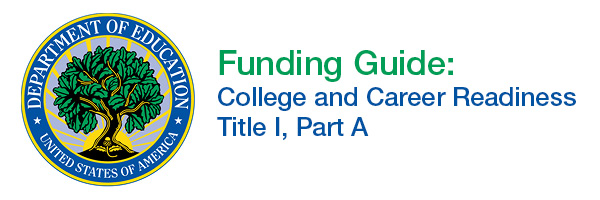Get the Funding You Need for the Technology You Want
 Recently we’ve summarized the qualifications for obtaining three of the five U.S. DOE funds: Race to the Top, 21st Century Community Learning Centers, and Charter Schools. Today we’ll do the same for Title I, Part A, College and Career Readiness. If you meet the qualifications for this fund, there’s a good chance you may be able to obtain the technology your classrooms need.
Recently we’ve summarized the qualifications for obtaining three of the five U.S. DOE funds: Race to the Top, 21st Century Community Learning Centers, and Charter Schools. Today we’ll do the same for Title I, Part A, College and Career Readiness. If you meet the qualifications for this fund, there’s a good chance you may be able to obtain the technology your classrooms need.
College and Career Readiness
The purpose of Title I of the Elementary and Secondary Education Act is to ensure that all children have a fair, equal, and significant opportunity to obtain a high-quality education and reach, at a minimum, proficiency on challenging state academic achievement standards and state academic assessments.
Title I funds must be used to improve reading and mathematics instruction for disadvantaged students. Allocations are based on the number of low-income children in states, districts, and schools. Funds typically target reading and math resources or services.
Title I programs emphasize college and career readiness, which is usually a natural fit for educational technology. Technology may be purchased using Title I funds if it helps in the delivery of curriculum, professional development, or other components for Title I students. If purchases are being made for an entire school, commingling funds from other sources to help cover the cost for non-Title I students is allowed.
Key Requirements
The key requirements for this funding are as follows:
- Student Achievement. Improve student achievement in reading and mathematics, as measured by end-of-year assessments.
- Close the achievement gap between minority and nonminority students.
- Close the achievement gap between disadvantaged children and their more advantaged peers.
- Meet the needs of low-achieving children, including limited-English-proficient children, migratory children, children with disabilities, Native American children, neglected or delinquent children, and young children in need of reading assistance.
- Disadvantaged Students. Focus on materials and methods that are effective with disadvantaged students.
- Meet the needs of low-achieving children.
- Meet the needs in the highest-poverty schools.
- Standards. Help students meet state and local student standards in core academic subjects, such as reading and mathematics.
- Students meet challenging state academic and content standards.
- Increased achievement overall.
- Increased achievement for the disadvantaged.
- Research-Based Methods. Offer instructional materials and strategies that are based upon research with proven efficacy.
- Access to scientifically based instructional strategies.
- Access to effective instructional strategies.
- Professional Development. A minimum of 5% of Title I funds must be set aside for professional development in the districts in which 100% of the teachers are not “highly qualified.” Funds may be reserved for ongoing and continuous professional development of staff.
- Elevating the quality of instruction.
- Providing substantial opportunities for professional development.
For more information about this fund, see http://www2.ed.gov/policy/elsec/leg/esea02/pg1.html.
Find Out How Interactive Technology Qualifies
To show you how Mimio technology ‒ hardware, software, or apps ‒ qualifies specifically for Title I, Part A funds, we created a free guide that can make it possible for you to get the technology you want for your school or district. You can download it today. >>
Not sure that this is the fund for you?
There are four more guides in the series, each of which focuses on a single fund and how Mimio technology qualifies:
- Title I, Section 1003(g) School Improvements Grants (SIG)
- Race to the Top
- 21st Century Community Learning Centers, Title IV, Part B
- Charter Schools
All guides are free and available for download. >>



